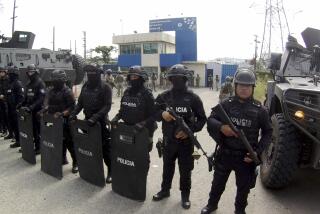Border Spat Has Escalated Into Heavy Combat : South America: Peru, Ecuador using mortars, artillery and bombs. Doctors say death toll tops official total of 47.
- Share via
GUARD POST ONE, Peru — In more than two weeks of bloody border conflict between Peru and Ecuador, skirmishes in the rugged jungle have escalated into heavy combat with mortars, artillery, bombs--and antiaircraft fire that has downed at least five Peruvian aircraft.
In a news conference Saturday, Peruvian President Alberto Fujimori confirmed that Ecuadorean antiaircraft batteries knocked out three Peruvian planes Friday.
The two Russian-built SU-22 fighter jets and a U.S.-made A-37 support plane were shot down near the Ecuadorean outpost of Tiwinza, where troops have been clashing for the past week.
“The shooting down of these planes by Ecuadorean artillery infiltrated at the last moment in the conflict zone is naturally a dangerous escalation which Peru is trying to avoid,” Fujimori said.
He said the pilot of one of the SU-22s was missing but that the others ejected safely.
Peru has also acknowledged losing two helicopters. Ecuador claims to have shot down four copters plus a Canberra bomber.
Each side accuses the other of starting the conflict, which erupted Jan. 26. The battleground is a 40-square-mile area on a 48-mile stretch of border that has been in dispute since Peru defeated Ecuador in a 1941 territorial war.
Guard Post One, known in Spanish as Puesto de Vigilancia Uno or PV1, is Peru’s forward base at the southern edge of the combat zone. Within the post’s perimeters Friday were four fresh craters that Peruvian officials said were made by Ecuadorean bombs.
“We came under hostile fire,” army Lt. Col. Manuel Lazarte told reporters taken by helicopter to the base, on the east bank of the Cenepa River. A Peruvian flag fluttered alongside a scattering of palm-thatched wooden huts tucked against a low hill.
Troops trained in jungle combat are airlifted by helicopter to PV1 from garrisons on the Maranon and Upper Amazon rivers. Going into battle from PV1, ground troops march for days through the knee-deep mud of mosquito-infested swampland and over densely forested foothills of the Cordillera del Condor range.
Ecuadorean troops are entrenched in and around the heavily fortified base of Tiwinza, fewer than seven miles by air northeast of PV1.
Although banner headlines in Lima, the Peruvian capital, have announced for days that Peru’s storming of Tiwinza is imminent, Peruvian army officers say that rough terrain and bad weather have hampered their assault. Ecuadorean troops also have an advantage at Tiwinza because their positions are on a hill overlooking the base.
“We’re advancing step by step,” Gen. Vladimiro Lopez told reporters at the town of Bagua. Lopez is commander of the army division headquartered at Bagua, which is Peru’s main staging base for the conflict.
Fujimori said last week that Tiwinza has been “softened” by saturation bombing in preparation for the final assault.
Ecuadorean Defense Minister Jose Gallardo Roman said Saturday that the bombs dropped at Tiwinza left craters 15 yards in diameter. Gallardo said Ecuador remains firmly in control of Tiwinza and of two other Ecuadorean bases that Peru claims it has seized in the fighting.
Fujimori said 36 Peruvians have been killed and 60 wounded, while Ecuador has acknowledged 11 soldiers killed and 26 wounded.
But the real death toll is much higher, doctors at a field hospital in Bagua said. According to these physicians, many bodies of Peru’s dead have never been recovered from the battlefield, and the wounded often die en route to PV1 because the trek back from the combat zone takes days.
Since Jan. 31, the United States, Brazil, Argentina and Chile have been mediating talks aimed at a cease-fire agreement between Peru and Ecuador. The talks are scheduled to resume Monday.
More to Read
Sign up for Essential California
The most important California stories and recommendations in your inbox every morning.
You may occasionally receive promotional content from the Los Angeles Times.













